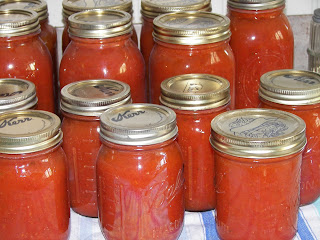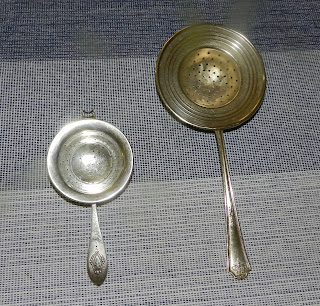I'm not sure the modern family is prepared for homemade catsup - it's an acquired taste because of the flavor, consistency and container. If you like the idea of knowing exactly what's in your catsup and the exciting fresh flavor, here's an easy way to prepare.
Easy Catsup
8 pounds - Ripe tomatoes - stem and quarter
2 - Ripe sweet red peppers - core & seed
2 - Ripe sweet green peppers - core & seed
4 medium - Onions - peel and quarter
3 cups - Vinegar
3 cups - Sugar
3 Tblsp. - Salt
1 1/2 tsp. - Allspice
3 tsp. - Dry mustard
1 1/2 tsp. - Whole cloves
1 1/2 tsp. - Whole cinnamon - break into a few pieces
1/2 tsp. - Hot red pepper
All vegetables should be washed and stems removed. Cut peppers into strips.
Spray my cooking container with PAM cooking spray.
Put vegetables in blender container (or food processor) in batches. Blend at high speed for 4 seconds, pour into cooking container.
Add vinegar, sugar, salt and stir. Tie the spices loosely in a thin muslin spice bag and add.
Simmer in a large oven roaster at 325 degrees. Cook until volume is reduced one half. Remove spice bag.
Immediately ladle into hot sterilized jars, seal and process for 15 minutes. Makes 5 pints.
Good General Information
Blending and cooking in the oven eliminates a lot of work. You don't have to use the food mill to process out the "chunks" and you won't have to stir to keep from sticking to the pan as you do with stove top cooked catsup.
If the reduced consistency isn't as smooth as you prefer, let the mixture cool a bit and run it again through the blender/food processor, return to boiling (stir to keep from sticking) and then can. Don't put hot foods in a blender as it will explode and burn you and make a huge mess. Plus, it's hard on the plastic. Re-blending does add more time and clean up to the process.
Once it's opened, home canned catsup will not keep in the refrigerator indefinitely the way store bought catsup does. Unless your family uses catsup really fast, I'd recommend canning in 1/2 pint jars.













































